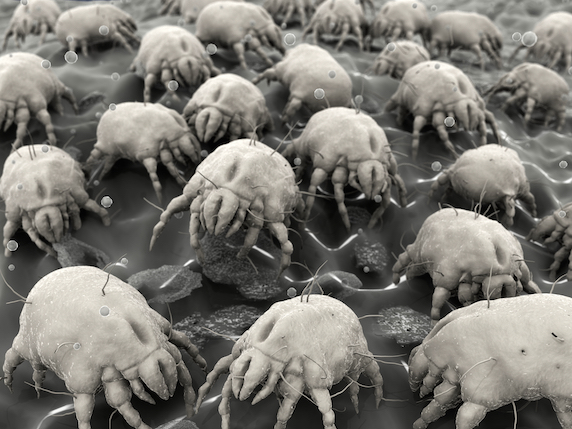
Dust mites consume shed human skin and other organic waste. Their feces can induce allergic reactions and are responsible for about 25 percent of all allergy diseases.
If someone told you there were new ways to solve old problems, how open would you be to learning about them?
Consider building-related illness (BRI). What do you know about the new ways to mitigate this pervasive problem, which continues to have a huge impact on health and productivity?
The Costs of Doing Business as Usual
According to a U.S. Environmental Protection Agency (EPA) report, indoor air pollution cost the nation “tens of billions” of dollars per year in 2000. The report suggested that, because of the relative magnitude of operating costs, labor costs, and rental revenue in most buildings, modest preventive measures would generate substantial returns. More recently, a 2004 report stated that senior management acknowledges even small improvements in office worker productivity deriving from facility maintenance projects are clearly worth it.
Benefits Outweigh Costs
Scientific research established that the office environment can influence health, well-being, and productivity, with studies showing that keeping an office looking good increases employee productivity. Additionally, when occupants are satisfied with their working environment, and can work in greater comfort and control, the cost of employment per worker drops – and the cost of facilities operation decreases.
The Origins of BRI
In 1976, Legionnaire’s Disease broke out in Philadelphia at a convention of the American Legion. Within a few weeks, more than 221 cases were tallied with 34 fatalities. Now known as legionellosis (caused by Legionella bacterium), this incident garnered immediate attention.
It took 10 years, however, before incidents like this became part of a larger concept, codified by the World Health Organization (WHO) as “sick building syndrome.” By then, the WHO estimated that 10 to 30 percent of newly built offices in the West had problems with indoor air quality (IAQ). Today, poor IAQ is known to be a main cause of allergies, hypersensitivity reactions, airway infections, and cancers. BRI is the term now used to describe specific symptoms that can be attributed to known contaminants within a building.
While not always the cause of BRI, ventilations systems are invariably involved. The problem is that too little attention is paid to the quality and maintenance of HVAC systems, which require not only regular cleaning, but also regular performance tests.
Underlying Causes of BRI
According to the EPA, IAQ is based on:
- Introduction and distribution of adequate ventilation air
- Control of airborne contaminants
- Maintenance of acceptable temperature and relative humidity
While there are many potential causes of BRI due to Nos. 1 and 3 above, the least addressed (until recently) has been No. 2: reducing/eliminating pathogens from bacteria, viruses, fungal spores, pollen, and especially dust mites and their feces dust.
In each cubic foot of air, there are millions of these pollutants. Dust mites and feces dust are responsible for about 25 percent of all allergy diseases, and a factor in 50 to 80 percent of asthmatics, as well as in countless cases of eczema, hay fever, and other allergic ailments.
New Techniques Improve Outcomes
During the last 10 years, there have been major shifts in understanding how to combat pathogens in buildings. The old objective was to kill bacteria with antibiotics, disinfectants, or antibacterials. That caused numerous problems, including making the bacteria resistant and turning them into superbugs (which has created ancillary problems for the medical community).
Based on what has been learned about how probiotics build immunity, scientists recently developed ways to use safe, food-grade probiotics (different from the lacto bacillus in yogurt) to break down biofilms and clean surfaces of all sorts of pathogens, including bacteria, mold, pollen, dust mites, and fungal spores, and even affect viruses.
These probiotics have also proven to be exceptionally effective at eliminating odors, and are now used by hundreds of hospitals, hotels, and commercial centers.
Even more recently, scientists developed methods for stabilizing probiotics in liquid form. These concepts are being applied to indoor air systems; highly specialized natural and organic probiotic-based aerosols are being injected directly into air supplies before the air even passes over the coils of air-handling units.
This technique helps slow or eliminate buildup on the coils, which prolongs cleaning cycles, improves thermal transfer, and enhances overall airflow and efficiencies – all of which save money (some studies have shown a 15-percent decrease in energy costs as a result of dispersing the right aerosol along with proper distribution throughout the ductwork). Moreover, studies have shown that cleaning air-handling systems in hospitals and healthcare settings plays a critical role in improving clinical outcomes.
These solutions not only protect the spread of pathogens by forced air circulation, but a building’s environment and surfaces are proactively protected by virtue of using the forced air system to help spread the probiotic. The result is less sickness, infection, and allergic reactions, which literally improves the health of people, buildings, and organizations, and improves bottom lines.
Probiotics (using fogging methods) are also being combined with preventive maintenance programs and furnishing refurbishment. Often overlooked, furnishings (especially woods, leathers, and upholstery) are ideal breeding places for disease-carrying pathogens, including bacteria, viruses, and dust mites. They need to be disinfected and preserved, not just wiped, dusted, or vacuumed.
In a study of 813 buildings supporting over 750,000 occupants, more than 75 percent of IAQ problems were traced to operating faults and/or poor maintenance; more than 12 percent were due to contamination inside the ductwork, with dust and allergic fungi comprising 60 percent of the pollutants.
Beyond just basic cleaning, proactive and productive facilities executives are using preventive measures to ensure that their indoor air is as unpolluted and odor free as possible, and to keep surfaces in hygienic condition.
David Ableman
David Ableman is VP of operations for PROTEK, headquartered in Randolph, MA, which specializes in duct cleaning and decontamination services and onsite refurbishment.

